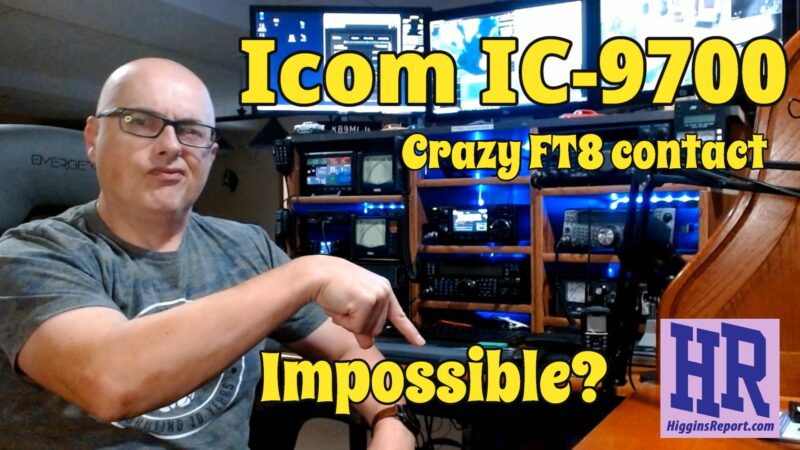
Amateur/ham radio has a rich history of experimentation, innovation, and a passion for exploring new technologies and communication methods. Among the modern advancements that have significantly transformed amateur radio is FT8, a digital communication mode that has rapidly gained popularity worldwide. Developed by Joe Taylor, K1JT, and Steve Franke, K9AN, FT8 represents a revolutionary step forward, offering amateurs a cool and highly effective means of communication even under challenging conditions. FT8 or not FT8? Is it for you…?
I recently made a crazy FT8 contact on the 2m band. 2m is not typically a band that is conducive to long distance contacts due to it “line of sight” characteristics. Sure, AMSAT can be used for some really interesting and impressive contacts. However, my crazy contact I believe was due to meteor scatter. Take a look at my Youtube video detailing the contact:
FT8 stands out due to its unique technical characteristics. Designed specifically for weak signal operation, FT8 can decode signals far below the audible noise level. This capability makes it especially valuable for operators with limited antenna setups, low transmit power, or those constrained by environmental conditions. By enabling reliable contacts over significant distances even under poor propagation conditions, FT8 has expanded the scope and accessibility of amateur radio dramatically.
One particularly cool aspect of FT8 is its incredible efficiency. Unlike traditional digital modes or voice communications that often require substantial signal strength, FT8 utilizes advanced digital signal processing algorithms, allowing operators to achieve successful contacts with minimal power. Often, amateurs successfully communicate globally using only a few watts of transmit power. This low-power capability not only reduces interference and conserves energy but also makes amateur radio more accessible to operators in densely populated areas or those using portable or emergency setups.
FT8 or not? Another appealing feature of FT8 is its automated and structured operation. Exchanges are concise, pre-formatted, and typically completed within 15 seconds, allowing for rapid and highly efficient communication cycles. This format is particularly suited to short openings in band conditions, enabling amateurs to make contacts during brief propagation windows that might otherwise be missed with traditional modes. Moreover, the standardized nature of FT8 exchanges simplifies logging and enhances the integration with online databases and platforms like Logbook of the World (LoTW) or QRZ.com, streamlining the confirmation process.
FT8 or not, well FT8’s role in fostering global communication is another major reason it has become so popular and widely regarded as a valid mode. It brings together operators from diverse regions and fosters international collaboration and friendship. Amateurs can easily establish contacts across continents, exchanging call signs and signal reports effortlessly, even when language barriers might make other forms of communication challenging. This global reach underscores the unifying spirit of amateur radio and highlights FT8’s significant contribution to promoting international understanding and cooperation.
The digital nature of FT8 also opens doors for experimentation and continuous improvement. Enthusiasts regularly participate in contests and awards specifically tailored for digital modes, pushing the boundaries of what is achievable with modest equipment. Additionally, FT8 serves as an excellent educational tool, teaching operators valuable skills in digital communication, propagation understanding, and station optimization. Its inherent stability and predictability provide a solid foundation for both novices and experienced amateurs looking to enhance their technical competencies.
Critics occasionally argue that FT8 diminishes the human element of amateur radio, suggesting it reduces operators to mere observers rather than active communicators. However, this perspective overlooks the reality that FT8 complements rather than replaces traditional modes. Operators frequently use FT8 alongside voice, CW (Morse code), and other digital modes, enjoying the varied experiences each mode offers. FT8 provides a unique solution when other modes are impractical, thereby enriching the overall amateur radio experience rather than diminishing it.
Moreover, FT8 plays a crucial role in emergency and disaster communication scenarios. Its ability to function effectively under weak signal conditions makes it exceptionally valuable when infrastructure fails or traditional communication channels become overloaded or disrupted. Amateur operators equipped with FT8 can reliably establish critical communication links, providing vital support during emergency operations and disaster relief efforts. Thus, the practical benefits of FT8 extend far beyond leisure activities, underscoring its validity and importance within the amateur radio community.
So, FT8 or not FT8, that was the question. The answer for me is FT8. I find it fun. Just like some find QRP fun. I’m amazed at how far reaching my contacts have been, never using more than 25 watts. FT8 has rapidly emerged as a cool, valid, and highly valued digital mode in amateur radio, distinguished by its efficiency, versatility, and ability to overcome challenging communication conditions. By enabling low-power, high-performance communication, it makes amateur radio more inclusive, accessible, and innovative. FT8 fosters global connectivity, encourages continuous learning and experimentation, and significantly enhances the practical capabilities of amateur radio operators. Far from detracting from the traditional values of ham radio, FT8 enriches and expands the hobby, ensuring its relevance and vibrancy for generations to come.
